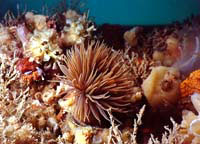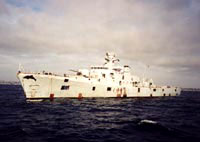Noelle Barger is operations manager for the San Diego Oceans Foundation (SDOF), a nonprofit organization devoted to promoting ocean stewardship through community-supported projects.

Monday, 26 Mar 2001
SAN DIEGO, Calif.
Imagine this: You are standing in front of a crowd of 100 people, your body is moist from what I call “the nervous sweat,” your voice is higher than normal because you are anxious, and all 200 eyes are on only you. You’re wondering if anyone can see the wet spots under your arms and, most importantly, you’re wondering if the Oreo cookie you just ate is still in your teeth. Your voice isn’t carrying to the back of the room, so you stand on your tiptoes and scream so no one misses the important information you are about to share. These are the situations that are only supposed to happen in dreams, right? Wrong.
It is early Monday morning and I am sitting at my desk reflecting on my Saturday afternoon, when that dream became a reality for me. Just two days ago, I was standing before a large group of scuba divers, pitching a project that I had spent the past five months developing for the San Diego Oceans Foundation. All 100 divers present had signed up to participate in our Artificial Reef Monitoring Research Project. They were there to learn how to become research divers. As I looked through the crowd, I was amazed at the intensity in everyone’s eyes. They knew they were embarking upon a project that was something special … the divers were ready to learn.

An anemone, one of the invertebrates we will be studying.
Photo: SDOF.
As soon as the training program was underway, my body settled down; it was now up to several others to carry the load. The volunteer divers were instructed on various topics related to artificial reef research. They were taught fish identification by Bob Burhans, the curator of fish at the Birch Aquarium. Then Ed Parnell from the Scripps Institution of Oceanography taught data collection methods, including how to count fish by using transect lines. Because the monitoring project will be conducted on artificial reefs in waters off San Diego, two scuba diving instructors reminded the volunteers of the importance of diving safety, especially when wreck diving in 100 feet of water. To encourage communication underwater, Laurieanne Askinazy from Seasigns taught the divers 25 signs related to scientific research. So, not only did the divers learn the proper data collection skills needed to make the monitoring project a success — they also learned sign language.
The training program was a great success: The San Diego Oceans Foundation gained 100 members and an entire army of research divers. The five months of preparation paid off — now volunteers can help us collect critical information on the life histories of marine species while scuba diving.
The San Diego Oceans Foundation is a nonprofit, volunteer organization that has been in operation since 1984. We rely entirely on volunteer support to make our programs successful. As the Operations Manager — and the only paid employee of the Foundation — I spend most of my days alone in the office, with an occasional visit from a volunteer or friend. Most of my communication is by email and telephone.

The Yukon, pre-reef.
Photo: Jim Robertson.
Last July, the Foundation purchased a 366-foot ex-Canadian destroyer ship called the Yukon, cleaned it with the help of more than 200 volunteers, and sank it for use as an artificial reef. It has been said that an army of ants carried the Yukon to San Diego — this army of volunteers is solely responsible for the tremendous economic benefits the Yukon has brought to San Diego. The dive-boat operator businesses have increased their profits by more than 70 percent, and local tourism is on the rise as well. I receive emails every day from people from around the globe who want to learn more about the Yukon and its placement as an artificial reef.
Now that the sinking is over, it is important for us to keep the volunteers active — to remind them that there is still work to be done. As if sinking a ship wasn’t enough, now we are asking them to biologically monitor it for us. Thank god for volunteers!
Today, I have a meeting with Sergio Angelini, director of engineering at Scubapro, and Steve Drogin, a very generous supporter of the Foundation. We are going to lunch to discuss funding opportunities for the Artificial Reef Monitoring Project. Wish us luck — no funding means no monitoring project!


